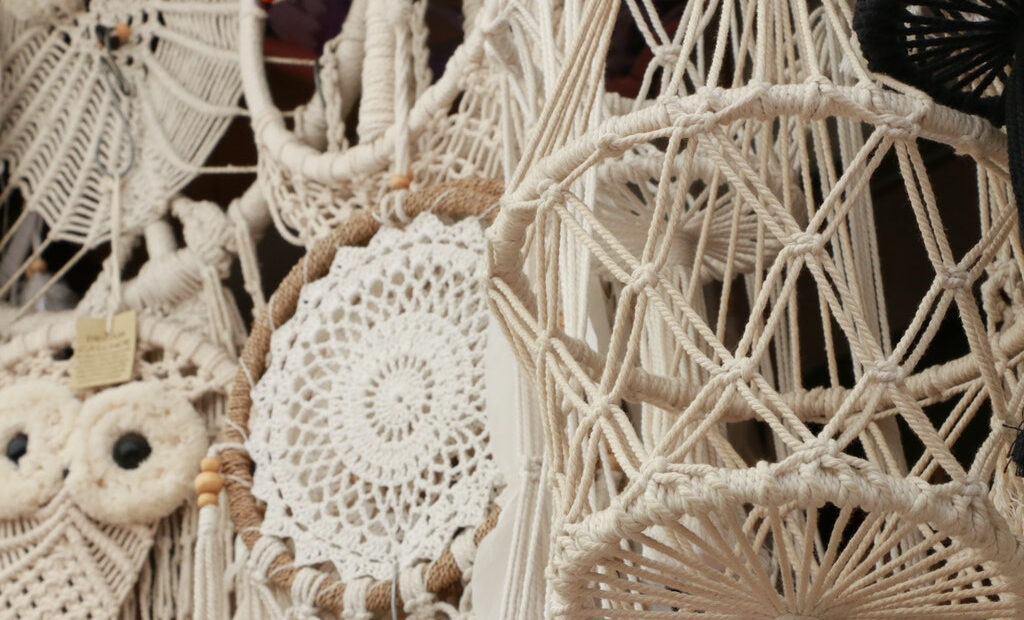A beginner’s guide to modern macrame

Simply put, macrame is the art of decorative knot tying. It’s a versatile fibre art that can be used to make everything from wall hangings and plant hangers to jewellery, clothing and purses. Makers can use simple materials such as cotton twine, yarn, jute or hemp. Dyed threads and wooden or glass beads can also provide many creative possibilities. This fun, retro crafting trend can be as simple or as complex as desired.
Various knots are constantly being revived by new generations of people who enjoy making art with their hands. Macrame has regained popularity since modern boho decor is a leading trend, evolving from the 1970s style to a hot art form. It’s possible to learn how to make macrame decor as it’s a broad crafting category, so anyone can find something to their liking.
Here’s some advice on how to to learn the basic techniques and begin making at home.
Practise how to do macrame
Practising allows crafters to become acquainted with various macrame names, knots and how to tie them. Most importantly, by the end of the project, it will be clear whether it’s a good idea to move onto the next project or macrame just isn’t the right thing. Finally, if one completes a practise project, the confidence will have been gained to invest your money and time in a “real” macrame project.
First, it’s necessary to choose the project to work on and look online to see what fits one’s individual style. It’s advisable to start small. Some options include knotting a chunky macrame wall hanging, cute key chains, bookmarks, plant holders, bracelets or choker necklaces. Those who feel confident can choose a bigger project like a hammock, table runner, rug or even a headboard, but it’s wiser to save the big projects for later. Once the project and style have been chosen, it’s time to look for a pattern.
Macrame resources and supplies
Macrame can be made with a wide range of natural fibres like jute, cotton and hemp rope, and synthetic fibres like synthetic craft cord and leather. The craft is mainly composed of square knots. This knotting won’t be complicated for anyone familiar with making paracord bracelets since both employ the same knots. For standard projects, one typically needs cords ranging in thickness from around 0.1 to 0.2 inches (3mm to 6mm). Micro-macrame is used to make small decorative items and jewellery, where the cord is 0.01 to 0.07 inches (0.5mm to 2mm) thick.
Here’s what’s needed:
- Painter or masking tape
- Tape measure
- Scissors
- Cotton macrame cord
- A metal or wood dowel, or a tree branch or driftwood for wall art
- A Hanging ring if making a plant hanger
- A rolling rack if making clothes
Most projects also need a macrame board to secure the work while knotting. The board can be made of various materials, but the main goal is to have a firm surface into which the pins can be inserted. For example, makers can use a piece of polyurethane, a cork board or two connected cardboard pieces. It’s just important to make sure to choose a board that is around 12 inches square and thick enough so to put a corsage pin or T-pin in without it poking out the other side.
Basic knots
One of the most fun things about macrame is that one can use many different knots. However, in the beginning, it’s worth sticking to the basic ones. Mastering those will be more than enough for a first macrame project.
Some basic knots are the square knot, lark’s head, reverse lark’s head, spiral and horizontal and vertical double half hitch. Of course, watching some video tutorials is a good idea to get a better grasp of the various techniques.
Modern macrame art
The colour palette of modern macrame has changed. Unless someone is trying to recreate a retro carpet from the 70s, macrame knots are typically made of one colour now – usually earth tones, whites or pastels.
However, there’s no need to stick only to these colours. Macrame can be made in a variety of shades and styles. It’s just decorative knotwork so crafters can go crazy! Besides natural fibres, like in the past, synthetic fibres, including paracord, are the most used in its recent revival.
Wrapping up
The next generation will look at 00s macrame and wonder how it was used as decor and think it must have been beautiful. It’s exciting that this trend from the 70s is back!
Anyone play with macrame however they want – in fact, one of its most appealing aspects is that no two patterns are identical, since macrame is hand-knotted and woven. Therefore, the patterns and colour combinations can be as unique as the maker is.
The editorial unit























Facebook
Twitter
Instagram
YouTube
RSS